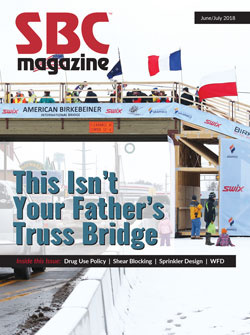Editor's Message: Bottlenecks
Editor's Message: Bottlenecks
Most of the conversations I’ve had with component manufacturers (CMs) about increasing production efficiency inevitably focus on one thing: bottlenecks. Put in a new, high-capacity saw only to find the truss members stack up as the assembly tables struggle to keep up. If you’ve gone through this process lately, you’re acutely aware how interconnected your entire operation is from start to finish.
As the nation’s economy continues to grow at a rate not seen in over a decade, and more and more people are contributing to the demand for housing stock, the shortage of jobsite labor is getting a lot of media attention. This is certainly a major bottleneck for builders. In a recent NAHB survey, 84 percent of homebuilders listed availability of labor as their most significant problem.
This is a good thing for CMs. Framing the American Dream proved structural components allow a crew to frame two and a half homes in the time it takes to stick-frame one house. Whether it’s roof trusses, wall panels or floor panels using trusses, components can address builders’ labor bottlenecks. It’s a great opportunity to grow market share for a wide variety of our industry’s products. That is, if CMs can actually meet a builder’s demand.
Unfortunately, there’s an even more serious bottleneck facing the entire supply chain and it’s just now starting to get attention: Transportation. The lack of available trucks, truck drivers and railcars are all reaching crisis levels. According to the American Trucking Associations (ATA), the shortage of over-the-road truckload drivers (drivers who regularly haul more than 100 miles from their point of origin) is currently 52,000, but they say more than one million additional drivers will be needed by 2024 to keep up with demand. ATA estimates 71 percent of all freight tonnage in the country is moved by truck. The current shortage of drivers presents an unprecedented challenge for anyone looking to haul freight.
To complicate matters, the new electronic logging device (ELD) regulations that went into effect April 1 are hampering existing drivers from getting the job done. For example, the Midwest Shippers Association says the ELD rules are limiting the ability of drivers in many agricultural areas from completing their hauls to ports, railyards and transloading facilities. This is creating major congestion issues, particularly at multimodal facilities, where goods are transferred from ship and rail to truck and loads are redistributed.
The primary alternative to trucks is rail, but there are very real challenges there as well. Canadian Pacific is struggling through a labor strike, Union Pacific has completely stopped shipping cars into Western cities like Las Vegas because of backlog, and Norfolk Southern and CSX are facing increased scrutiny by federal regulators over delivery delays as well as crew and rail car shortages.
The growing transportation bottleneck is having a significant impact on the ability of North American lumber producers to transport finished lumber from the mill to end users. At the most recent SBCA Board meeting, a representative from Georgia Pacific laid out in great detail their struggles to get logs to their mills and, more importantly, get lumber out to CMs. As the transportation bottleneck becomes more acute, it will likely have an even larger impact on the cost and supply of readily available lumber.
If you are experiencing transportation struggles, either in getting raw materials delivered, or in finding drivers to haul your products to the jobsite, let us know. We’d like to begin quantifying the ways in which this issue is impacting our industry.

